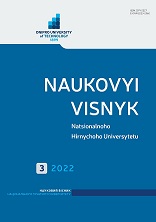
Бази даних
Наукова періодика України - результати пошуку
 |
Для швидкої роботи та реалізації всіх функціональних можливостей пошукової системи використовуйте браузер "Mozilla Firefox" |
|
|
Повнотекстовий пошук
| Знайдено в інших БД: | Реферативна база даних (4) |
Список видань за алфавітом назв: Авторський покажчик Покажчик назв публікацій  |
Пошуковий запит: (<.>A=Matsyuk I$<.>) | |||
|
Загальна кількість знайдених документів : 4 Представлено документи з 1 до 4 |
|||
| 1. | 
Matsyuk I. M. Search of variants of assemblies of structural groups in planar linkages [Електронний ресурс] / I. M. Matsyuk, Т. I. Morozova, E. М. Shlyahov // Науковий вісник Національного гірничого університету. - 2017. - № 2. - С. 65-69. - Режим доступу: http://nbuv.gov.ua/UJRN/Nvngu_2017_2_11 Purpose. To determine the effect of the presence of prismatic kinematic pairs on possible versions of assemblies of the structural group of the third class in modern planar mechanisms. Methodology. In the work an analytical study is carried out of possible assemblies of a four-link third class structural group, in which there are prismatic kinematic pairs in two links. The study was carried out using Mathcad mathematical packages. Findings. Possible variants of the mutual arrangement of the links of a third class structural group at fixed positions of its external kinematic pairs are found. A polynomial of degree six is obtained and all its coefficients are defined. It means that the polynomial is of degree six both for the structural group with two prismatic pairs and for the group with revolute pairs. It is shown that, for the variant of the group under consideration, the search for assemblies reduces itself to finding the real roots of a sixth-degree polynomial. Dependences of the polynomial coefficients on the geometric parameters of the structural group are obtained. The finding of the roots of the polynomial is performed using the standard procedure of the Mathcad, which does not require specifying the initial approximations of unknowns. Originality. It consists in determining the number of possible assemblies of a four-links third class structural group, in which two links have prismatic kinematic pairs. It has been determined for the studied structural group that maximum assembling number is four. Practical value. The results of the research can be used in designing the mechanisms of new machines when choosing a specific variant of assembly of a third class structural group appropriate in the best way of set problem. The search for possible assemblies of third-class structural groups can be carried out numerically with the help of modern computer technologies, which makes it possible to determine both the number of possible solutions and the solutions themselves without specifying initial approximations. | ||
| 2. | 
Matsyuk I. N. Some aspects of synthesis of linkage of complex structures [Електронний ресурс] / I. N. Matsyuk, E. М. Shlyahov, O. I. Yehurnov // Науковий вісник Національного гірничого університету. - 2018. - № 3. - С. 57–63. - Режим доступу: http://nbuv.gov.ua/UJRN/Nvngu_2018_3_10 Purpose. To study possible variants of assemblies of the fourth class Assur group consisting of four links and to evaluate their impact on operation of the mechanism containing this Assur group. Methodology. The paper shows the results of theoretical study of possible assemblies of the fourth class Assur group in a jaw crusher in which both jaws move. The study was carried out with the help of the MathCAD software. Findings. It is shown that the planar fourth class Assur group used in the jaw crusher features the following: only two assemblies are possible for conventional configuration of three-joint links against the frame; assembly mode significantly affects the quality of the crushing process; assemblies can be located very close, which can cause spontaneous transition from one assembly to another in heavily loaded mechanisms and result in an emergency situation. Originality. It has been established that in the planar fourth class Assur group the number of possible assemblies does not exceed two. Very close mutual arrangement of assemblies is possible. Position functions of mechanisms with different assemblies differ from one another. Practical value. The action algorithm is proposed. Used at synthesis of planar mechanisms of the fourth class, it allows evaluating their possible assemblies. | ||
| 3. | 
Matsyuk I. M. On applying high-class mechanisms of heavy-loaded machines [Електронний ресурс] / I. M. Matsyuk, E. М. Shlyahov, O. I. Yehurnov // Науковий вісник Національного гірничого університету. - 2019. - № 3. - С. 68-73. - Режим доступу: http://nbuv.gov.ua/UJRN/Nvngu_2019_3_11 Purpose - to evaluate the impact of possible variants of assemblies of the fourth class Assur group as a component of a jaw crushing machine on the machine runnability. In this paper, a theoretical study of possible assemblies of a fourth class Assur group, which is part of a jaw crusher, was carried out. Based on the conducted research it is found that the number of possible assemblies of the group in this mechanism without its reference to the crushing machine is equal to four. While applying this mechanism in the crushing machine, the maximum number of assemblies equals two and they can be in a close proximity, which can result in emergency. The originality in the work involves defining the number of possible assemblies of the fourth class Assur group. For the group under consideration it has been established that the maximum number of assemblies equals four. An algorithm of finding a zone of possible positioning of a driven crank of a crushing mechanism is suggested, which allows influencing the remoteness of two closely-spaced assemblies. The search algorithm of possible assemblies of the fourth class Assur group with the help of Mathcad program can be used when manufacturing similar crushing machines. | ||
| 4. | 
Matsyuk I. M. Substantiation of rational drive parameters for reliable operation of heavy-loaded mechanisms [Електронний ресурс] / I. M. Matsyuk, E. М. Shlyahov, O. I. Yehurnov // Науковий вісник Національного гірничого університету. - 2019. - № 5. - С. 55-59. - Режим доступу: http://nbuv.gov.ua/UJRN/Nvngu_2019_5_11 Purpose. To evaluate the influence of driven crank parameters on the location of different sets of a mechanism with the fourth-class structural group. Methodology. A theoretical study on the influence of the input crank parameters on the positioning of different sets of the mechanism of a double-jaw crushing machine using the Mathcad software was carried out. Findings. It is shown that: the center of rotation and the length of the crank in the fourth-class mechanism should be positioned in a certain area; the choice of specific positioning of the crank can eliminate the dangerous proximity of two adjacent sets of the mechanisms of the fourth-class structural group. Originality. An algorithm of defining a zone of positioning the rotational center and length of a crank is determined for plain mechanisms of the fourth-class structural group. It has also been found that probability of spontaneous transition from one assembly to another closely-spaced assembly in heavy-loaded mechanisms can be reduced significantly by choosing the appropriate rotational center of a crank. Practical value. An algorithm of actions is proposed, which makes it possible to choose an assembly which ensures its good functioning during the synthesis of a plain heavy loaded mechanism of the fourth class. | ||
 |
| Відділ наукової організації електронних інформаційних ресурсів |
 Пам`ятка користувача Пам`ятка користувача |